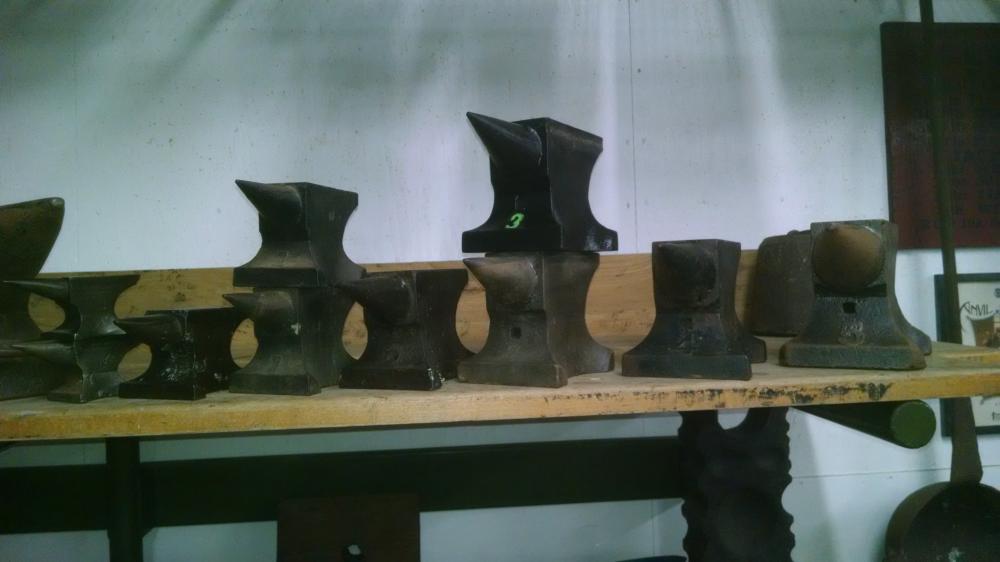-
Posts
2,481 -
Joined
-
Last visited
Content Type
Profiles
Forums
Articles
Gallery
Downloads
Events
Posts posted by njanvilman
-
-
17 hours ago, natenaaron said:
I've got a nibble on the anvil line. Some guy knows a guy, who knows another guy whose granddad might have had one. I was told it might be pretty dinged up. Is it possible to put it through a resurfacing machine if it passes the bounce test?
Get it first. Look at it, Post photos. Test it. Then comments will be more informed, not just speculation.
-
I have and use an Iron City 8" post vise. Very heavy duty, and a beautiful forging. Weighs about 210 lb. I had another identical to it that I sold on ExxY a few years ago for big $$.
Fisher #6 double chain vises weigh about 200 lb, and have 8" jaws.
-
This is a new variation of Fisher products that I have never seen before. I did not even know that such a design existed before seeing this one.
The patent was written as a way to use the vise without it being attached to a bench. It was a way to make it "portable", or at least able to be moved. It did take up a lot of floor space.
-
The turbo pe-charges the Roots super charger for a LOT of boost. A 5' muffler is probably enough to take the ring out of the expansion chamber. The "mufflers" on the drills and our trucks were only about 2-3' long and not near enough to mute the ring when you got the engines rapped up on the pipe. Gobs of power in a small package like any 2 stroker.
Probably the worst problem they had was if you stalled them at the wrong moment and got them turning backwards, say dumped the clutch and "killed" it. They run backwards just fine but the oil pump doesn't pump oil running backwards. Everything else seems to be running normally but it's lifespan is measured in tens of seconds before it starts grinding to a hard stop. Your best clue is getting it in gear and the rig going backwards.
excellent engines if you can live with the quirks.
Frosty The Lucky.
The 6V53T engine in the truck is mated up to an Allison automatic. Not much chance of running backwards in this rig.
-
Fisher used a cast tool steel horn piece on all of their anvils. The steel piece on the horn was NOT hardened. Separation was no more common on the horn as the face. Most held up over their lifetime. Some horns and some faceplates failed, either through a defect or improper use.
The 800 lb Fisher anvil is the biggest know to have been cast for use. Yes, there is the 1400 lb Centennial anvil, but it was more for exhibition than use. Fisher did advertise that they could make a 1000 lb anvil, but I have no records of any being made, and none have surfaced publicly.
The museum has an 800, and I have seen two more. The one you mention is the fourth one that I have heard about. If you are ever there, could you photograph it from all sides? Thanks.
-
Thanks Nick, I buffed off that spot and thought it was an 8 as well but the more I stared at it, the more it looked like part of the casting.
So, with Fishers, it is common to see one number to indicate a weight below 100 LBS?
Nice FISHER! Yes, Fisher for the most part used one number below 100 lb, but not always. Same with bigger one. Sometimes a 100 lb would have a 10, or sometimes a 100. Depended on the moldmaker and the era the anvil was made.
I believe your anvil is from the 1920's, based on where and how the Fisher name is.
Check out my Fisher & Norris Factory Museum Page on FB for more pictures and information.
Any other questions, just ask.
-
Just to keep you fully informed, those marks on the face and the side were caused by someone using an oxy-acetylene cutting torch over the anvil. The super-heated slag and oxygen jet eroded/burned out some of the steel faceplate, and on the side. As long as there are not more of these in the center work area of the face, it is not going to affect it function. But it does take away some of its value. With this damage, $3/lb is probably going to be the upper end. (Note to all: I am not interested in this anvil. I am on the other coast, 3000 miles away.) I am sure a smith in the west will be glad to get this Fisher.
-
I have a 6V53T in my 1963 B Mack firetruck. Yes, is has a turbocharger and the internal supercharger. The muffler is over 5' long. Lots of power from a relatively small block. I cannot even imagine the sound it would make without the muffler...
-
I think the above poster is referring to the first picture, about 1 1/2" in from the heel end. It has what appears to be a vertical line on the side. I think is is just a paint line or something else, but not a crack.
-
If that is a 30, it is a 300 lb. 20 would indicate 200. If it is too hard to make it out: 300 lb Fisher has a face width of 5 1/4" and a face length of 19 3/4". A 200 lb Fisher has a face width of 4 3/4" and length of 17 1/4". This will give you and easy way to determine its weight.
You can also go for a wider audience than a local one with a major on-line auction site, if you participate.
That anvil, if sound, and it a appears so, should bring $3 to $5 lb. You are a seller, not a buyer, so what other people have managed to buy anvils for has absolutely no bearing on you price you ask or what you sell it for.
-
Nothing will happen with the Big Fisher until at least Jan 2018, and NJ gets a new Governor. The present administration has de-funded the museum so much, that it is operating on a shoe-string budget. No displays will be changed until then. They are not interested in any weigh-in. The museum has the anvil on display in a "made in NJ" section. They were not interested in displaying any smaller Fisher anvils that reflected what the company produced in quantity. I offered to lend them anything.
-
The working area looks fine. Post a few more pictures of the rest of the anvil please.
-
The big FISHER in the NJ State Museum is about 60" long, the face is 9", and it is about 22" tall. It is said to be 1400 lb, but has never been weighed on a certified scale. If it ever comes off exhibit, I will try to borrow it, and the first stop would be a weigh-in.
I am sure the English anvil makers also made big anvils for these exhibitions. I hope they too survive to this day.
-
Now that you are part of the FISHER family, if you ever want to see my Fisher & Norris Factory Museum, PM me here or at njanvilman@gmail.com. I am only about an hour and a half ride for you, in central NJ. Check out my FB page under the same name. You will get a history lesson about Fisher anvils, and see more Fishers than you ever thought existed.....
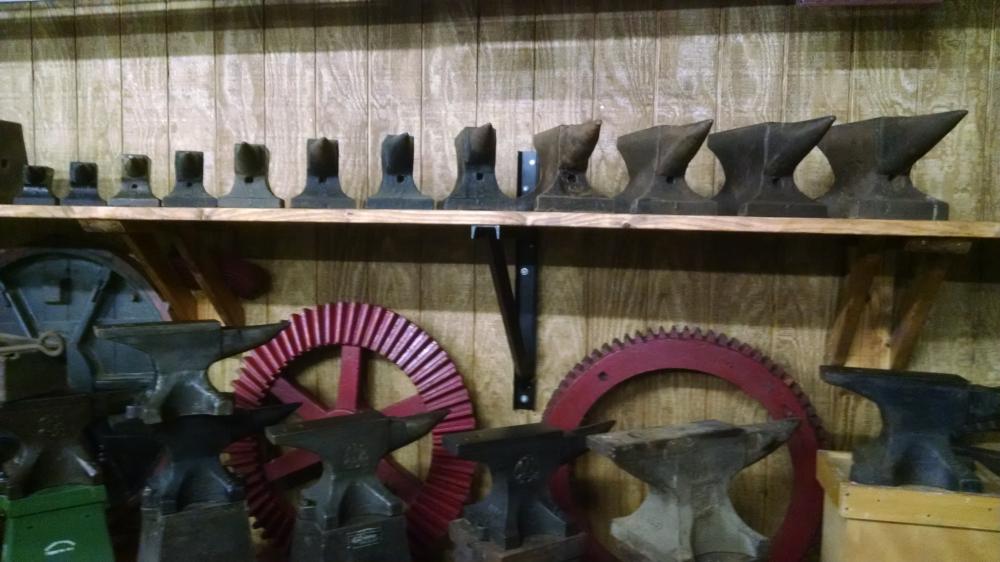
-
It is a FISHER. That is the logo that they used in the late 1860's. It is an Eagle holding wheat stalks, similar to what is on coinage. The 8 indicated it started life as an eighty pounder +/-.
-
Probably an inspector's mark. Exact function and meaning of some of these marks are lost to history.
-
Did you sell out of apples ? Dave
Steve Prillowitz? of Matchless Antiques sells the apples. He sold a lot, but I left before the end, so I do not know if he sold out.
-
NJBA has been going through some hard times. Our president passed away suddenly last year, and our web/newsletter person has been ill. Our membership has been shrinking, and like all groups, it is hard to get anyone to do anything.
We are still active. We have an open forge most Mondays in Howell, just off Rt 9. We just have not had any big events for a while.PM for more information.
-
A good QS for me, even though I left early. Picked up two anvils on the way out, found three more at QS, and left Saturday morning to get another. Coming home was a NOS 250 lb Fisher, absolutely mint(the rearmost anvil). Two almost NOS 100 lb Fisher/Crossley, a 130 lb Colonial, a broken STAR, and a 54 lb French "Pig" style double horn. On top is a custom Aaron J Cergol monster claw hammer, made for me. I even sold some stuff too.
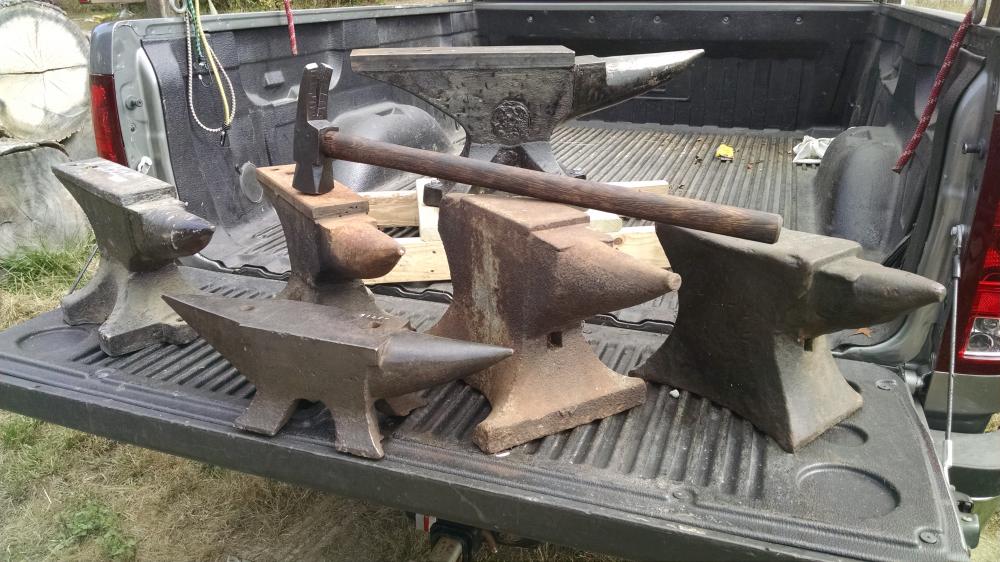
-
This anvil is now in the Fisher & Norris Factory Museum.
To bring it home, I took a 900 mile detour after Quad States to Missouri. Lots of touring our Interstate Highways, but a good although long drive.
-
-
Final loading today. Heading out by 4 am tomorrow. 10+ hour drive for me.
-
It looks to me that the serial # is A64105. If that is correct, the anvil was forged in 1906. If the 1 is not in the middle, and the #6405 is correct, it is from 1899.
Trenton anvil were made by the Columbus Forge and Anvil Co, in Ohio.
What is it worth? Depends on condition....where it is located....and most importantly: What would you accept $$ wise to part with it??
-
See my post above. Just use a final coat of straight Boiled Linseed Oil on the base, touching the concrete. Or several. It will last for years.

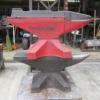
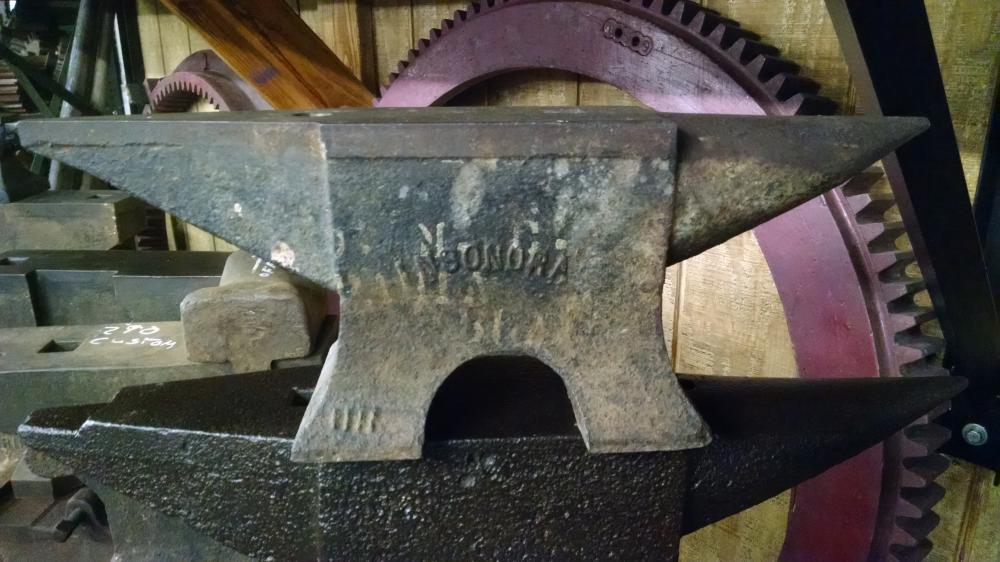
Fisher
in Anvil Reviews by brand
Posted
I recently added the missing anvils to this group of Fisher anvil in the Fisher & Norris Factory Museum. These are all early(1850's), made in Trenton, NJ. They are the style without a cutting table. Horn and face only. On the right is the biggest, a #5(50 lb). #4, #3, #2 are in 10 lb increments. The #1 is 15 lb, and the #0 is 10 lb. The two small ones on the left are about 3 lb, but have no size markings. Yes, I have duplicates of three of them.
This style Fisher anvils are very rare. My biggest is a #5. I do not know if Fisher made this style in anything bigger. If anyone has one bigger than 50 lb, please post an image or let me know. I am trying to ascertain what Fisher made to make my upcoming book as accurate as I can.
3